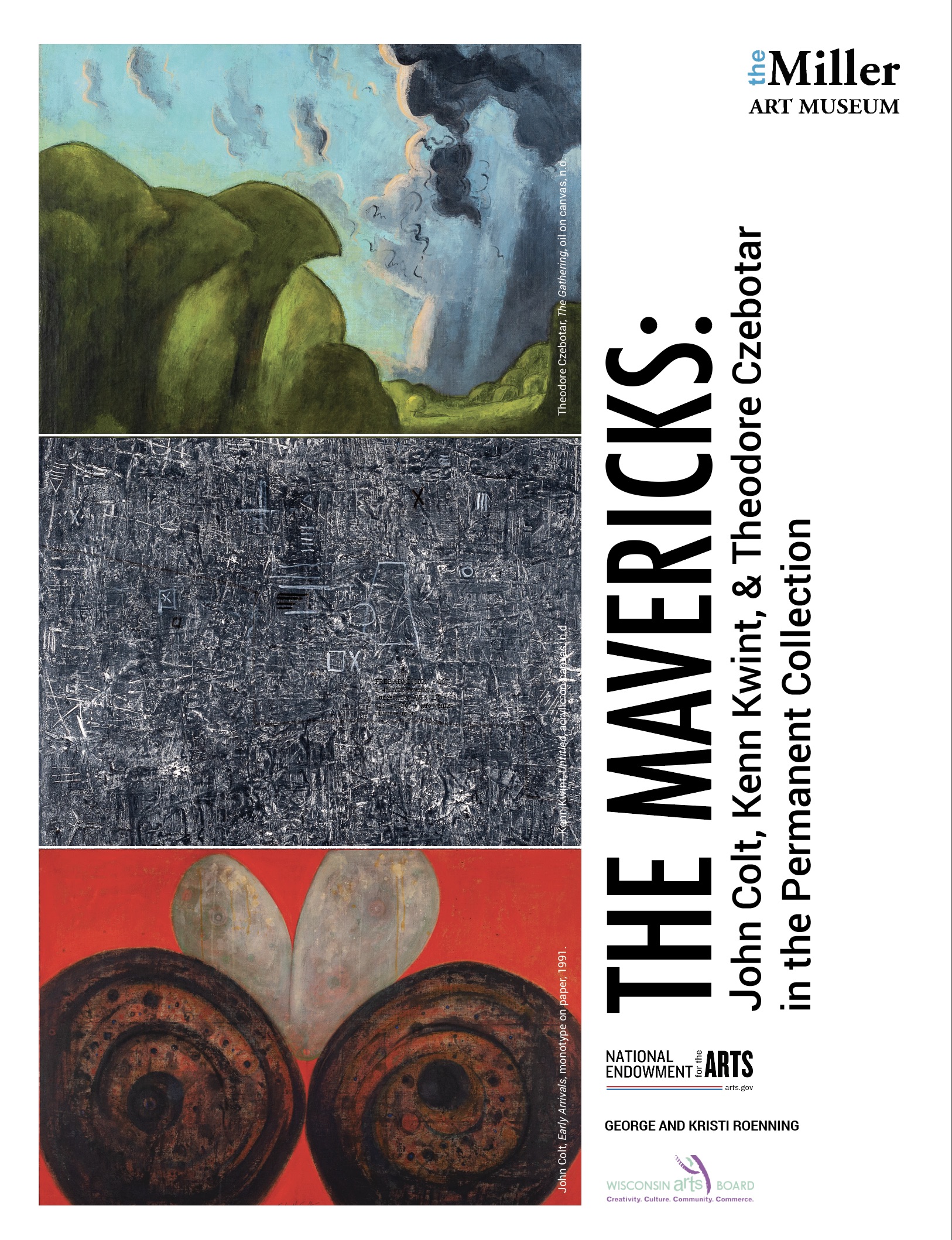November 1, 2024 – The Miller Art Museum is pleased to announce the opening of its final exhibition of 2024, The Mavericks: John Colt, Kenn Kwint, and Theodore Czebotar in the Permanent Collection. The exhibit will open to the public with a free reception on Friday, November 15 from 4 - 6 pm. The exhibit will be on display at the art museum, located in the Door County Library downtown, through December 30.
 This exhibition showcases a selection of 41 artworks and sketchbooks, gifted by the Kohler Foundation, Inc. in 2019, from Celebrated Wisconsin artists John N. Colt (1925–1998), Kenn Kwint (1937–2020), and Theodore Czebotar (1915–1996). Each piece invites the viewer to explore the unique vision and approaches that define the artists’ careers. Through Colt’s abstract compositions, Kwint’s bold expressionism, and Czebotar’s evocative landscapes, the exhibit highlights the diverse techniques and artistic depth of these figures, celebrating their contributions to modern American art and the Wisconsin art community.
This exhibition showcases a selection of 41 artworks and sketchbooks, gifted by the Kohler Foundation, Inc. in 2019, from Celebrated Wisconsin artists John N. Colt (1925–1998), Kenn Kwint (1937–2020), and Theodore Czebotar (1915–1996). Each piece invites the viewer to explore the unique vision and approaches that define the artists’ careers. Through Colt’s abstract compositions, Kwint’s bold expressionism, and Czebotar’s evocative landscapes, the exhibit highlights the diverse techniques and artistic depth of these figures, celebrating their contributions to modern American art and the Wisconsin art community.
Born in Madison, WI, John N. Colt was a pioneering figure in the Wisconsin art landscape––a master colorist in both painting and print. He was the son of art educator Arthur Colt, who taught at the University of Wisconsin-Madison. Following in his father’s footsteps, Colt worked as a professor at the University of Wisconsin-Milwaukee from 1957 until his retirement in 1990, where he influenced generations of artists, emphasizing a disciplined yet experimental approach to art. His work often explored organic forms and intricate textures, reflecting a deeply personal connection to both natural and constructed environments. Colt’s legacy endures in Wisconsin as a maverick who expanded the boundaries of modern art.
Kenn Kwint, a lover of modernism, was born in Milwaukee and began painting at the age of 13. He attended the Layton School of Art in Milwaukee and apprenticed in the studio of Plato Prokopis from 1959 - 1961. Throughout his life, Kwint was also a poet and jazz musician and both of these hobbies informed his artwork. This multifaceted background contributed to his artwork’s rhythmic, expressive style, which often incorporates dense layers of paint and materials like marble dust and oil to create textured, evocative surfaces.
Kwint’s work embraces abstraction with imagery that is at once subtle and bold, remote, and recognizable. He was fascinated with cave paintings, primitive art forms, and the language of mark-making, all of which act as a bedrock for a primitive, symbolic language. The artist’s figurative works embrace expressionism and are imaginative representations that take a face-to-face dive into a psychological inner world that unapologetically depicts the monstrous side of the human psyche.
Theodore Czebotar was born in Milwaukee, the second child of eight to Polish immigrant parents. As a passionate young child, Czebotar was a self-taught artist and poet who traveled extensively by jumping trains and hitchhiking. During that period of his life, Czebotar was very poor, spending time in hobo camps, trading sketches for food, and camping in farm fields and cemeteries. Czebotar’s early sketches caught the eye of American Regionalist John Steuart Curry, who introduced them to the renowned gallerist Maynard Walker. Enchanted, Walker gave Czebotar his first solo exhibit in December of 1937, just two years after he established the Mayard Walker Gallery in New York.
Not long after, Czebotar became disillusioned with the commodification of art. Abandoning the art world, he embarked on ‘into the wild’ excursions, camping for long periods in the most remote environments he could find, searching for rugged terrains to paint. He explored the Hudson Valley, Olympic Peninsula, Washington State coastlines, and Southwestern deserts, sketching and painting darkened seas, piles of driftwood, oncoming storms and saguaro cacti, in his quest for the aboriginal in nature and for primordial revelation. Czebotar’s work gained recognition through support from notable American Regionalist artists and art dealers, leading to exhibitions at significant institutions like the Milwaukee Art Institute and the Brooklyn Museum.
While each artist’s personal story, distinct creative process, and visionary perspective establish a shared connection among them, it is ultimately the artwork itself that unites them. John N. Colt, Kenn Kwint, and Theodore Czebotar each embraced abstraction, expressionism, and innovative mark-making techniques in unique ways, dedicating themselves to subjects and methods that defied convention. The result is an exhibition that, while eclectic in style and approach, speaks in a cohesive and resonant language, celebrating each artist's commitment to exploring the uncommon and the extraordinary.
With subject matters ranging from explorations into the world of insects and tiny creatures by John Colt, the symbolism and primitive language that offers a bold look into the human psyche of Kenn Kwint, to the foreboding landscapes in rough, rarely visited terrains by Theodore Czebotar, the works are bound together by the unique passions of the individual artists.
Together with The Mavericks, an exhibition titled Site Specific will be featured on the Ruth Morton Mezzanine. It encompasses 22 works from the permanent collection that depict recognizable Door County from artists Charles L. Peterson, Austin Fraser, Jack Anderson, Mary Mayhew, Joan Champeau, Rosemary Utzinger, Armando Zeledón, William Jacobs, Jessie Kalmbach Chase, Richard Hildebrandt, Frank Penchman, and Lorna Bell Cornell.
